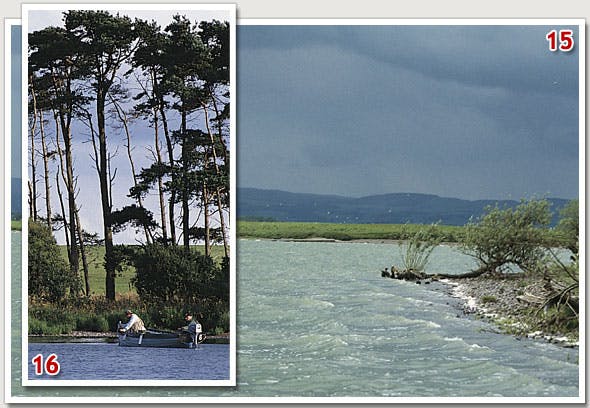Loch Leven is Scotland’s most famous trout lake with an angling history stretching back to Victorian times. Today it is the country’s premier competition water. Ian Muckle is your guide to the many drifts and marks on the 3,400-acre loch.
LOCH LEVEN is a lowland freshwater loch lying on rich glacial debris, enriched further by alluvial material carried in from the surrounding farmland. It is a relatively shallow venue, with over three quarters of its bottom covered by less than 15ft of water.
The name of Loch Leven is synonymous with trout angling in Britain, and its historical significance in the sport is legendary. When it’s on form, there’s nowhere to touch it, though when it’s in one of its moods, it’ll break your heart.
I’ve been lucky in that I live only 10 minutes away - and have been even luckier in having fished the loch with top names like Francie Jarrett, David Chalmers jnr, Jock Cowan, Craig Cowan and several others; guys who are skilled in interpreting Leven’s many moods, and who know the loch like the back of their hands.
If you want success in one of the major competitions on Leven, just pray that you draw Francie, Davie, Jock, Craig or one of the other Leven gurus as your boat partner. I’m certainly grateful to these guys for all the information they’ve shared with me over the years.
The magic of Loch Leven lies in several factors. Its sheer size is part of the formula, since you can drift over so many different areas each offering a variety of angling situations. The 50 boats are another bonus - roomy, stable 18 footers, some of which have been on the loch since the turn of the century, all equipped with reliable outboard engines.
The history of the place plays its part too, especially if you’re drifting off Loch Leven Castle where Mary Queen of Scots was once imprisoned. The modern facilities are a fairly recent addition, with new buildings, an extended harbour and the establishment of the National Game Angling Academy bringing the venue bang up to date.
But probably the trout themselves provide the largest contribution - those unique native brownies on which Leven built its reputation, and the silvery hard-fighting rainbows, the larger ones of which look more like grilse and take off like runaway express trains when hooked.
Having worked out the wind and located the banks, how do you go about tackling up? During the day, there’s very little surface activity, so either use a fast sinking line, experimenting with variable speeds, or an intermediate fished three to six feet below the surface. A variety of patterns can work, from larger lures such as Lead Head or Humungus; through to the popular mini Cat and mini Viva variants; to the old favourite Leven traditionals, such as Kingfisher Butcher, Dunkeld, Greenwells and Invicta.
The floating line can be essential in the early morning and evening sessions, teamed with Suspender Buzzers, Snatchers and dry flies such as the Hopper family; or wet patterns like the Yellow Owl. The loch’s first double figure rainbow, a superb 10lb 3oz specimen caught by Davie Downie, came to a Claret Hopper fished in very shallow water behind Castle Island during an early morning session in 1997.
UNDERSTANDING THE WIND
The points of interest map link below show the main boat areas at Loch Leven. The key directly below explains which drifts fish best on different winds.
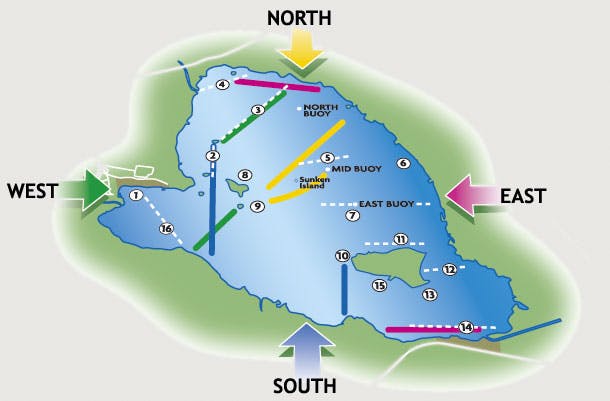
WIND
DIRECTION
BESTAREAS
Trickiest
NE
Over the face of the bank covering the Shallows; Mid Buoy to Reed Bower
Prevailing
SW
Scart to Old Manse Bay; North Queich to Green Isle; Gairney Mouth to Point of St Serf’s; Thrapple Hole
Warmest
S
Alice’s Bower to Scart; Scart to Green Isle; Carden Bay to Point of St Serf’s
Coldest
E
North Shore, Sluices to Duncan’s Corner
WIND DIRECTIONS
WIND strength and direction are very important on Loch Leven, and angling opportunities here are greatly enhanced by a knowledge of where to fish in certain winds. But possibly the most important piece of information is understanding how a change of wind can affect the loch.
Leven’s brownies in particular are famous for switching off when there’s a change of wind direction during the day. There’s nothing more annoying than to practice for a major Leven competition for a couple of days before the event, suss out the taking areas and then find that the wind changes overnight, blows from a different direction and your best laid plans are up in the air.
The secret of success on Leven is to fish along the banks where the depths change from six feet to around 25 feet. So whatever the direction of wind, choose a drift which will take the boat along one of these banks. What should be added is that those famous Leven boats are as safe as houses in wind strengths that would put boat fishing out of action on other venues.
1) The Kirkgate Bank
ON the left as you leave the harbour, this area is one of those drifts which is normally fished as a last stop on the way back at the end of a session, and rarely as the first place to visit. The water is shallow, and there is quite a bit of weed growth during the Summer. But it can certainly produce a few surprises, and it’s not only stockie rainbows which frequent this area. Some very decent brown trout have been taken from the Kirkgate Bank over the years.
If you can manage a drift parallel to the shore towards Harry’s Pier or from Harry’s Pier towards the harbour, or moving onto the shoreline, this will produce the best results, and you’re therefore looking for a westerly, an easterly or a south-westerly. Fast sinking lines are of little use on this drift because of the shallow water and the weed beds.
Top tip: Fish it right in until you’re almost dropping your flies on the shore.
Best times: Throughout the season.
Best winds: East, West, South-west.
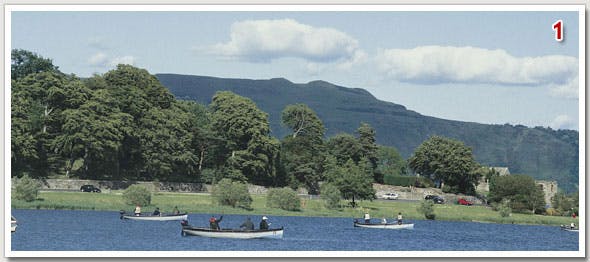
2) Alice’s Bower to Scart Island
LEAVING the Kirkgate Bank on your left, turn North between the little island of Roy’s Folly and the larger Castle Island, and you’ll come to Alice’s Bower. Do not attempt to go between Roy’s Folly and the shoreline as a shortcut - it’s very shallow here, and the chances are that you will ground the boat.
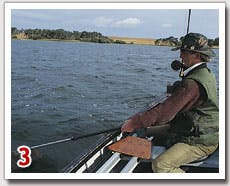
Between Alice’s Bower and the next little islet of Scart is a drift which is seldom fished, but which can always be worth a try when some of the better-known marks are not fishing well. The depths vary from around 3ft to 12ft, and there is an underwater ridge between the two islands. Brown trout are the main quarry here, and mini lures pulled on a Di-7 or Hi-D, or a Di-3 or Wet Cel 2 when the fish are higher in the water, will do the necessary.
Top tip: Try patterns with gold/black or silver/black combinations.
Best times: Throughout the season.
Best winds: South, though the drift will work in reverse.
3) Scart Island to Old Manse Bay
The tiny islet of Scart marks the beginning of one of the loch’s major drifts in a South-west wind, from Scart to Old Manse Bay on the North shore. The start of the drift is very shallow, deepening in the middle over the North Deeps to around 70ft, and then gradually becoming shallower as you move over the shelf marked by the North Buoy and into the shallow water of Old Manse Bay. It’s a top area for brown trout, though each year sees some quality rainbows, including some of the larger specimens, being boated here.
Intermediates and slow to medium sinkers are popular in the Spring months, though with the fast sinkers and mini lures like the Cat family, Viva and Prairie Dog also very much to the fore. Summer evenings or early mornings can bring the floaters into use, along with various Hoppers, Buzzers, Snatchers and even traditional wets like the Dunkeld and Kate McLaren. If the wind is more from the direct South, then the drift from the Scart to the Green Isle can also be pretty productive at times.
Top tip: Be prepared to change lines, with the weather conditions dictating the tactics.
Best time: May to mid June, and then again in September.
Best winds: South-west.
4) North Queich Mouth to Green Isle
THE North Queich is one of Leven’s major spawning burns, and the drift off its mouth towards the Green Isle is a very popular and productive mark at most times of the season. It’s a top run for decent-sized brown trout, with the back end producing some real heavyweight “yellow bellies”. This is also a time to pick up specimen rainbows, which are feeding on the perch fry.
It’s an area which is full of submerged branches and other obstructions, so that tackle loss will occur if you’re using a sinking line. But the shelves and ledges mean that the trout love to hang around this environment, and it’s well worth chancing your end gear. You should be drifting over water from around 5ft deep to around 12ft. Go for a medium or fast-sinking line along with lures such as the Humungus and Lead Head, or some of the Leven mini lures, to pull the bigger browns.
Don’t worry if the wind runs you parallel to the burn mouth and on to the Burleigh Sands, since many nice mixed baskets have come from this sandy-bottomed shallow stretch.
Top tip: Make sure you locate the shelves and fish over these.
Best time: Throughout the season, but August/September can be excellent.
Best winds: South-west, South.
5) The Elbow and ‘Triangle’
THE Elbow is an all-season mark which can produce fish on day, morning or evening sessions. The buoy marking this feature forms one of the points of what the locals know as the ‘magic triangle’, the other two points being formed by the buoys marking the Sunken Island and the Mid Buoy. This is brownie country, though you do pick up rainbows as well.
If the wind is blowing from the South-west or West, a favoured breeze for this area, the range of depths over the drift is considerable, from around 25ft to 10ft and sometimes shallower. Day sessions mean the use of a Hi-D, Di-7 or Di-6 along with lures in black/gold and black/silver; mini lures like Cat and Viva; flashy wet flies such as the Dunkeld; or if the fish are higher in the water, a Wet Cel 2 or Di-3, and add wets such as the Claret Bumble and Soldier Palmer to the list. Warm evenings or early mornings indicate floating line tactics, along with Hoppers, Snatchers, Buzzers and various dries.
Top tip: Keep an eye on the depth; you may have to count down more over the deeper water.
Best time: Throughout the season.
Best winds: South-west, West; or a North and north-westerly from the Elbow to the Sunken Island.
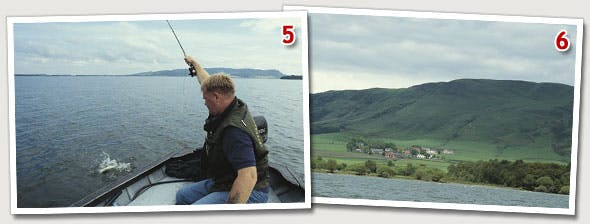
6) The Black Wood and Shallows
THE Black Wood lies behind the Shallows, an expansive area of very-shallow water over a mainly sandy bottom. It’s not an easy area to fish, although those regulars who are in the know about this part of the loch do very well.
The secret is to fish the drop-off where the thin water starts to fall away into deeper stuff. On a calm bright day, this is pretty obvious, with the dark line formed as the loch shelves away clearly visible. But in rougher conditions or in coloured water, you can’t see this, and you’ve really got to know the area.
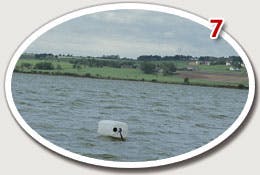
A North-west wind can take you along the edge of the shallows keeping to the face of the bank, or in a North-east, some anglers set themselves up near the mouth of the Pow Burn and drift over the shelf. Some fine brown trout are taken every season from the Shallows.
Top tip: Find that drop off, or fish with someone who knows the area.
Best time: Throughout the season.
Best winds: North-west.
7) East Buoy over the Shallows
ALTHOUGH this is a mark which can work all season, the final six weeks can be very productive for class brown trout. I remember fishing the East Buoy with twice Scottish Champion Davie Malcolm a few years ago in September when we boated 17 brownies all in the 2lb to 3lb 8oz range.
On that day, we were pulling Hi-D lines very quickly, using black/gold lures which the fish found irresistible. Mini lures of the Viva variety as well as those in yellow and in orange can also work well. In the evenings, the floating line comes into its own, along with dries like the Claret Hopper or Ginger Hopper. Claret Shipman’s Buzzer and Fiery Brown Shipman’s are also useful.
Heavyweight rainbows are often hooked in the early part of the season. In a West wind, you’re drifting from 12ft to 15ft of water into around 3ft ; in an easterly, this is of course reversed.
Top tip: When looking for those aggressive browns, be prepared to pull the lures back as quickly as you can when using a fast-sinking line.
Best time: Throughout the season.
Best winds: West, East.
8) Back of the Castle
YOU’LL often find that anglers go behind the Castle because it offers sheltered water when the rest of the loch is rough. Indeed, the best sport I’ve ever enjoyed here was on a wild and woolly day in a southerly, when Francie Jarrett and I sought refuge in this spot and had a field day boating quality brown trout. Maybe they were sheltering too!
The area holds some excellent fish of both species, and because the surface is often covered with insect shucks and adult flies from the overhanging trees, the dry fly and Buzzer enthusiast can do well here, especially on the early morning and evening sessions.
I’ve seen boats going the whole way in a South wind from the Back of the Castle over the North Deeps, or in a South over the Elbow and Sunken Island. A minor problem is that the bay is frequently disturbed in the Summer by the ferry bringing visitors to the Island.
Top tip: Have a floating line and dries set up, and watch for rising trout.
Best time: Throughout the season.
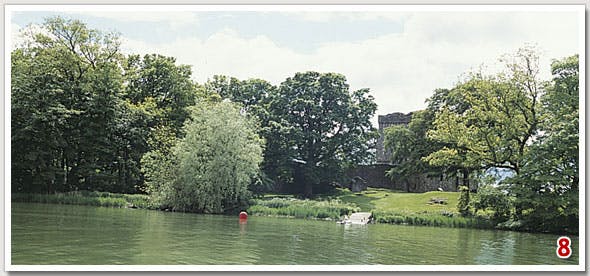
9) The Reed Bower
THIS is the other Bower, the island which lies next to Castle Island. Most drifts are made at the back of the Bower, and anglers can expect to contact both browns and rainbows. Two winds are the most useful - a north easterly, which means you can start off at the Mid Buoy and drift on to the left hand side of the Bower, fishing it right in to the shallow water; and a south-easterly, which dictates beginning the drift North of the South Deeps and running on along the front of the island.
A Hi-D or Di-7 are useful lines during the day or when the temperatures are low. Come up to an intermediate in warmer conditions, or if the fish are higher in the water. Use the range of lures and mini lures normally favoured on Leven.
Top tip: Fish the reed beds close into the back of the Bower.
Best time: Throughout the season, but especially in September.
Best winds: North-east, South-east.
10) The Point of St Serf’s
THIS is one of the most popular drifts on the whole loch, and is certainly my own favourite section for both browns and rain¬bows. I’ve had my two best Leven trout from here - a 5lb12oz brown and a 7lb10oz rainbow, both caught in around a foot of water.
I prefer the drifts which take you right on to the point, so my favoured winds are from the South, West or South-west. But this part can fish well in almost any wind direction, and of course you can extend the drift eg: go from the point of St Serf’s to the East Buoy in a southerly. I’ve had fish casting almost onto the shoreline and I’ve had them well out in the deeper water.
A favourite tactic in the past couple of seasons has been to drift from the ‘pink buoy’ over the South Deeps on to the point in a north-westerly, covering a whole range of depths. Tactics depend on conditions, and a whole range of lines can work; from a fast sinker plus lures of the Humungus or Cat’s Whisker type, through to floaters with Buzzers and Hoppers. Two 11lb plus rain¬bows came from the Point of St Serf’s this season.
Top tip: If you’re a stranger to the water, you could do worse than head for this area.
Best times: Throughout the season.
Best winds: Most winds.
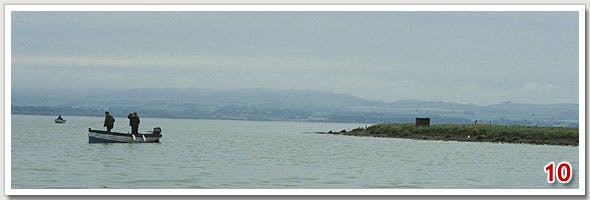
11) East side of St Serf’s
I’VE got to admit that I avoid this drift like the plague, purely because I really don’t know it well enough to have the confidence to fish it in this very shallow water. But top Leven man David Chalmers Jnr gave me the lowdown on this area, which has produced some of the heaviest Leven rainbows, as well as some great brown trout angling.
It is an early season mark, tending to weed up as the Summer progresses and become too weedy for comfort. You’re working from the Narrow Neck across the section known as the Sand Bank, using short drifts over water which varies from three feet to 15 feet. Use a fast sink line so you can cover all the depths, and try not to disturb the shallow water at the end of the drift. Lures in black/silver and black/gold can do really well, as can mini lures of the Cat and Viva family.
Top tip: Minimum disturbance is a must in this shallow water - be careful you don’t get stuck on the sand.
Best time: April to mid June.
Best winds: South, South-east.
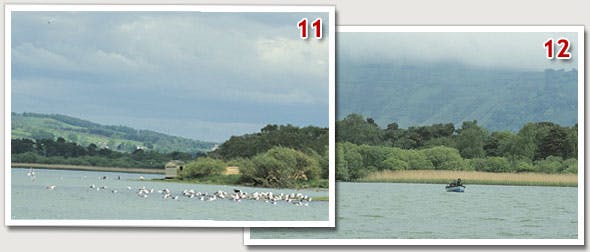
12) Hole of Inch
THIS used to be one of my favourite parts of the loch, although I haven’t done so well there in recent seasons. Having said that, the Scottish National Final was more or less decided there a couple of years ago, and this season has definitely seen an upsurge in the fortunes of the ‘Hole’.
Whichever way you drift, whether it’s from East to West or vice versa, you’re covering mainly shallow ground, though with bumps, ridges and trenches as you go. Both species can be contacted, and your lines can run from a fast sinker to a floater, depending on conditions.
Much of the bottom is sandy, and there’s also considerable weed growth at times. In the early season, a lot of sport is enjoyed at the erosion baskets on the eastern shore¬line. However, I’ve always reckoned the last part of the drift in an East wind - close to the shore of St Serf’s - to be the most produc¬tive, though it shallows very quickly.
Top tip: Look out for underwater vegetation once the Summer has added warmth to the water.
Best time: Throughout the season.
Best winds: East, West.
13) The Willows
THIS is the area of trees covering the South-east point of St Serf’s, and it’s a real favourite with early morning or evening anglers, especially in a light West wind. If trout are showing on the surface, as they often are in the early and late sessions, then a floating line with Buzzers or dries can be a killer - Hare’s Ear Suspender Buzzer, Claret Suspender Buzzer, Shipman’s, Claret Hopper or Fiery Brown Hopper are all mentioned in dispatches.
If no trout are visible on top, go down with a medium or fast sinker along with JC Viva, the Cat family and Prairie Dog; or large Humungus types in black/silver or black/gold. The Willows is a top section for contacting some of the larger overwintered rainbows.
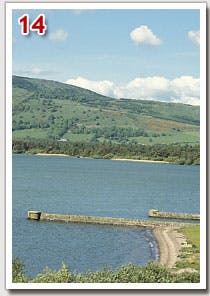
Top tip: Fish the early morning session to see the Willows at its very best.
Best time: May to August.
Best winds: West, North-west.
14) Duncan’s Corner to the Sluices
ANOTHER fairly neglected drift on the loch, though it can be responsible for some great catches of both rainbows and browns. With a West wind, the depths fluctuate, going from two feet, through four, into 10, and then back to three, rising again into eight to 10 feet of water. Weed beds appear in this area from May onwards, and anglers can find success fishing right alongside these.
Traditional patterns, though seeming to be on the decline among Leven anglers, can still be worth a try here - Greenwell’s, Yellow Owl, Dunkeld and Black Pennell being quoted, mainly on an intermediate line. However, the floating line and dries can be a major tactic as the Summer progresses. The area from Old Levenmouth to the Sluices should always be visited while in this area.
Top tip: Pay particular attention to the drop off points or as you lift on to the shelves.
Best time: Throughout the season.
Best winds: West.
15) Dunlop Bay and the West side of St Serf’s
EARLY morning and late evening are the times to be here, especially in a light South wind, or South-westerly. This whole area can be absolutely heaving with rising trout on some of the really warm dawn or evening sessions. Dunlop Bay itself (marked on the map by Sandy Point and Pier) is only two feet deep, but a couple of hundred yards out, the depth drops to 60ft, and if you’re fishing towards the East Point, 15ft to 20ft.
The whole area from Dunlop Bay to the East Point is a number one section for large rainbows. Brownies can be found by taking a line from Carden Point to the old stone pier in Dunlop Bay, though no further than 100 yards out from the shelf. An interme¬diate line is recommended, along with Suspender Buzzers in orange, olive and black; or CDCs on a floater. Calm conditions are best for these methods.
Top tip: Look for the scum lanes, and fish in these.
Best time: June, July and early August.
Best winds: South, South west.
16) Thrapple Hole and Kelson Strip
THIS is the last mark coming back to the harbour on our circular tour - or the first if you go right instead of left on leaving the anchorage. It’s a top section both early and late in the season, and produces some fine rainbows in May and June and some heavy brownies towards the back end when they’re waiting to run the burns. There’s quite a bit of weed in this region, and there¬fore plenty of feeding, including perch fry.
You’re working in depths of eight to 14ft, and one of the best winds is a light warm South-westerly. Mind you, the Kelson Strip can work well mid season with a light east¬erly during the day, and if fish are up then, try Hoppers, Orange CDC and Black CDC. In the earlier months, give the Wet Cel 2 a swim, along with mini lures of the Cat and Viva family worked with a figure of eight retrieve. Later in the year, try Suspender Buzzer in yellow or in green, or Hoppers in similar colours.
Top tip: Watch out for the weed beds, especially in high Summer.
Best time: May, June, September.
Best winds: South-west, East.
